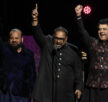

Why blame film-makers?
- 21st July 2010
- POST IN :UNCATEGORISED
There has been much talk for years about bad film-making. There is never a shortage of critics who would go the extra mile to ‘assassinate’ a film-maker for making a movie that’s just crappy. But one wonders how much of what a film-maker makes is self-motivated.
I am sure no sane film-maker would spend time, energy and money (usually someone else’) to wilfully make a movie that won’t sell. The film industry is after all a business and profit-making is the order of the day. Nevertheless, bad movies do come our way, and we are quick to throw brickbats at the man who made it.
Any economist would confirm that the engine that drives business is demand. When there is a demand, supply originates. It’s common to find people walking about wearing masks these days, but I don’t remember seeing that happen pre-H1N1. A lady I know made almost half a million Malaysian Ringgit is about two months selling masks online. She saw the demand and went on to hit the jackpot.
The same is true with the entertainment industry. Film-makers can only see profits when they feed fans with whatever fans demand. Once in a while we see a rare gem among them who goes on to make a movie that’s different only to bite the dust. When creativity and an out-of-the-box thinking isn’t welcome at the expense of a big hole in one’s pocket, how can we blame film-makers for not being motivated to make good films?
The greater onus to have good films made lies with the viewers. When they start rejecting crappy movies, they send a strong message that better movies are expected. Constant evaluation and consistent judgement from the viewers will surely create a demand for better movies.
Sadly that consistency is missing from Tamil movie viewers. There was a time during the 80s when ‘masala’ movies were big hits. By today’s standards on wonders how those movies made it to the blockbusters list. I believe it had to do with more than just the expectations from viewers. It had to do with how fans defined Tamil cinema.
A Rajini movie without a fight was a mortal sin. Kamal was always expected to dance and Y G Mahendran was the regular rib-tickler. And how can we forget the item numbers by Jayamalini and Silk Smitha?
Into the 90s, almost none of the above changed. The constants just kept adding. Just Kaundamani and Senthil had many cash registers ringing. When they split, there was a marked difference. Comedy was never the same again.
The limitations set upon actors and directors were placed there by the viewers. Nasser once said on Malaysian TV that the great Sivaji Ganesan was an under-exploited actor, because all Tamil fans wanted him to do was to make them weep – and none did it better than Mr Sivaji Ganesan. Kamalhassan mentioned recently that a roaring lion called Sivaji was ‘killed’ by the industry by just feeding him with curd rice.
It’s mind boggling how good movies such as Mahanadhi, Hey Ram and Anbe Sivam could crash at the box office. Even Rajini’s movies in which he played memorable characters such as Sri Raghavendra and the recent Kuselan failed, while a typical ‘masala’ like Sivaji the Boss could become a blockbuster. Don’t blame Rajini or Shanker, they only gave what the viewers wanted, but can anyone tell me what cultural or social impact did that movie offer? Absolutely zilch.
In almost 80 years of Tamil cinema, nothing much has changed. Yes, we have progressed technically but we have failed miserably in creating fans who would appreciate the potential of the medium. It isn’t enough to make a film with a difference once in a while. What needs to be done is to use this powerful medium to educate viewers on film appreciation.
What most viewers fail to see is that the quality of films made is a true reflection of their cultural and social mindset. World cinema has grown to the extent of affecting society positively. In an interview many years ago, director Balu Mahendra (a rare Sri Lankan Tamil born film-maker who made it big in Kollywood with innovative story lines and cinematography – he made notable films like the bi-lingual Kamal Haasan/Sridevi, Moondram Pirai in Tamil and Sadma in Hindi) mentioned about a movie taken somewhere in Europe that highlighted a prevailing legal problem in that country that made it difficult for its citizens to enjoy certain benefits. After the movie was released, the government actually reversed that legislation in the citizens’ favour.
I can’t think of any Tamil movie that has had such an impact on the Tamil Nadu government, let alone the Indian government, and the reason is simply that Tamil cinema fans are not keen on seeing transformational cinema. The limitless powers of the medium has been reduced to mere mediocre entertainment.
Educating viewers on film appreciation would be a great move in creating awareness that entertainment need not be void of social transformation. In fact, cinema is such a powerful media that it overshadows politics hands down.
Former Tamilnadu Chief Minister, Mr Kamaraj had this to say after watching the movie ‘Ratha Thilagam’, a Sivaji Ganesan starrer. He said that what could be said by politicians in a year was propagated in just 3 hours.
Film appreciation is basically about social consciousness. When the mindset of Tamil cinema viewers is transformed to be appreciative of their cultural richness and its impact on society, the demand for quality movies would increase. Tasting success in the film industry would no longer be an issue.
I have intentionally avoided talking about the technical nuances of film-making. Those are the minors compared to the real issue. Tamil cinema is never short on talent and presentation, but seriously suffers content of value. Sadly the content is being dictated by viewers.
Film-makers will continue to make mediocre movies as long as this cultural revolution doesn’t take place among Tamil cinema viewers, not because they wish to do so, but because that’s what keeps the money rolling.
So, is it really fair to always blame the film-makers? You only get what you want.
Words: Joseph David
- Previous Post
White guy raps in Tamil!






















